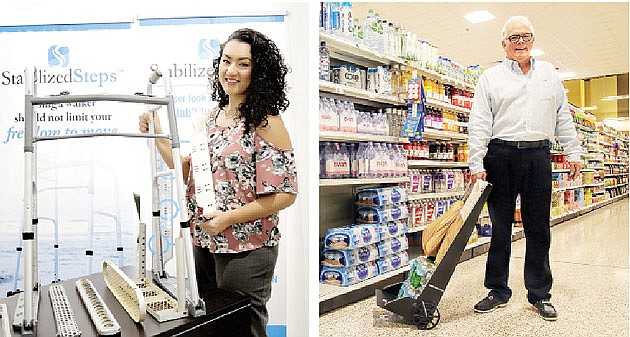By Ted Carter and Beth Luberecki | Contributing Writers
Editor's note: Two entrepreneurs, each based in Southwest Florida, aim to bring new inventions to market. While independent of each other, each product helps people move easier — either stuff or the users themselves. These stories examine the process of going from invention to marketplace.
Stabilized Steps
Former commercial bank loan officer Stephanie Gomez is headed into the medical equipment market with a walker accessory that she thinks is a genuinely better mousetrap.
She just might be right, judges at the Medtrade show in Atlanta tell her.
The object of Gomez's enthusiasm and the thumbs up from the trade show judges is a pair of gliders designed to return some giddy-up and increased mobility to an estimated 4 million Americans who rely on medical walkers to get around.
Invented by Punta Gorda residential contractor Eryk Hardwick, the gliders attach to the legs of a walker and have pads made of nylon, plastic and fiberglass tested through computer-aided engineering to withstand 500 pounds of pressure. With the pads, the walker can push forward through a sandy beach, gravel, grass, mud and snow without sinking into the ground. Indoors, the gliders help movement across carpet, tile and wood, Stabilized Steps officials say.
The early-stage company sells the gliders and legs that attach to a walker for $129. It has plans to eventually sell a walker with the gliders.
The plan is also to eventually market a variation of the glider that will use rubber pads. These, Gomez says, will let a user with enough upper-body strength raise the walker up and down with sufficient stability not to fall frontward, backward or sideways.
By the end of the year, Stabilized Step will receive the first 2,000 pairs of gliders and leg attachments. “We're going to hit big and must be ready for that,” says Gomez, predicting the products will be in 1,500 medical supply stores and pharmacies nationwide.
They also hope to hit it big with judges for the Medtrade Innovative Retail Product award at the Medtrade show in Atlanta scheduled for Oct. 23-25. The show hosts some 400 exhibitors a year.
One of eight finalists for the award, Stabilized Steps will make a three-minute pitch to the judges and an audience of trade-show visitors. “Your product best met the criteria as being suited for retail/care-tail sale and the judges felt it would best contribute to providers bottom lines though cash sales,” writes Kevin Gaffney, Medtrade's Group show director, in a letter detailing Stabilized Steps placement as a finalist.
Going to market is just what Gomez needs after a year of development expenses. The list of startup costs includes a concept patent and application for a manufacturing patent.
The married mother of a 2-year-old covered most of the expenses with credit cards and a second mortgage on her home. Her largest expense was the $25,000 mold she bought for the plastic injection process used to make the gliders.
The company has been taking pre-orders at StabilizedSteps.com, and expects December delivery of 2,000 pairs of gliders and leg attachments from its Chinese manufacturer. “One of the main changes will be the inflow of cash,” Gomez says.
Then, she says, the product finally “will not be just an 'idea.'”
Hardwick's part in development of the gliders goes back 40 years, when as a youngster he watched his uncles pour concrete. “They would tamp the rocks down for a smooth finish” using a tamper, he says.
He noticed the tamper could be left on the freshly poured concrete without sinking or falling over. The reason was expanded metal, where lattice-patterned openings helped to distribute weight throughout the surface, keeping the tamper upright, he says. “I built basically that plate I remembered from the concrete tamper,” Hardwick says.
The glider's holes prevent suction from occurring and making a forward push difficult. Increased stability is achieved by connecting the gliders to the walker's front and rear legs.
Gomez first met Hardwick when he came to her consulting business for help getting the glider to market. Gomez soon went from consultant to business partner.
Needing to find a manufacturer, Gomez turned to David Ferguson, president and CEO of Naples' Ferguson Management Services. Ferguson secured a manufacturer and also became a partner.
Gomez, looking at the next phases of the business, is particularly excited about the new mobility the gliders will give her fellow Floridians who retire “to paradise only to get stuck indoors.”
Happy Shopper
Whether you come home from a shopping trip with a case of wine or a dozen grocery bags, lugging everything from the car to the house isn't always the easiest of tasks.
And if you live in a city and do your shopping on foot, carrying everything gets even more difficult. That's why Naples resident Eric Parker created the Happy Shopper, a lightweight, foldable polypropylene cart that can handle more than 50 pounds of purchases.
The idea was born when Parker was a consultant for Berkshire Hathaway company Marmon Holdings, working within its retail sectors. He already had 35 years' experience at Illinois Tool Works, where he led its product development center. At Marmon, an $8 billion industrial conglomerate, he focused on boosting innovation in various company sectors. It was through those efforts that the basic idea for the Happy Shopper was first developed.
Marmon decided against doing anything further with the idea, so when Parker's consulting gig was over he got the preliminary patent for the Happy Shopper turned over to him. “Then I had to get into spending my own money,” he quips.
He hired a patent attorney and has since secured utility and design patents, with another one pending. It's been about five years since the original idea was first formed, and Parker has invested more than $100,000 in developing the product.
“I used to say when I worked at Illinois Tool Works that everything takes twice as long as I think it should,” says Parker. “Now with me being the chief cook and bottle washer, it takes five times as long. But my greatest strength is I don't give up — and my greatest weakness is I don't give up.”
Made of waterproof extruded polypropylene and reinforced with galvanized steel edging, the Happy Shopper weighs only four pounds and can be pulled with one hand like a carry-on suitcase. Seven hooks provide spots for hanging bags, and additional hooks can be added for transporting dry cleaning. Because the wheels are placed on the side of the unit with no wheel-to-wheel axle, it folds to just more than 2 inches thick and can be easily stored in a car trunk, behind a door or beside a refrigerator.
“Most of the competition is made of metal, which is strong but heavy,” says Parker. Things like “granny carts” also require shoppers to put purchases down into a box-like area, and it can sometimes be difficult to remove them.
Through cold calls and numerous meetings, Parker has assembled a team of U.S. companies that make and assemble the Happy Shopper's components — a fabricator that cuts out the design, a company that makes the wire forms, and a fulfillment center. The wheels are sourced from China.
“Conceptually, this is a completely outsourced business,” he says. “At ITW, we'd say you do what your core technology is and everything else you should outsource. Otherwise you have a bunch of people doing things someone else could do better.”
Parker is also working on another phase: courting investors. He got what he considers a beta test for the product after a recent Naples Daily News profile on the Happy Shopper. He received about 40 orders following that story, and another 40 when it re-ran in a Fort Myers newspaper. “It gave us an operational test,” he says, “and now I'm ready and confident in the product.”
Parker created an online store, happyshoppercart.com, that sells the cart for $29.95. He'd love to get in a small to medium-sized retailer and grow from there. He also sees potential for the product at wineries, duty-free shops and trade shows, and labels could be applied with company logos.
“The neat thing about what I have is it can be a walking billboard,” he says. “But how much of an incentive that is for retailers I have yet to find out.”






